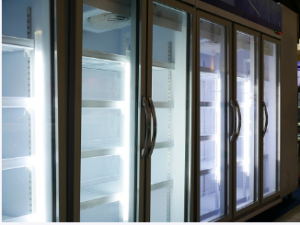Your refrigeration must operate efficiently to preserve food and beverages at ideal temperatures. A poorly managed refrigerator could result in spoilt inventory and increased energy costs.
An empty refrigerator uses more energy than one fully stocked with food. Filling your walk-in coolers and refrigerators can reduce energy usage and emergency freezer repair costs.
Refrigerators
Commercial refrigeration Adelaide comes in an assortment of styles to meet the needs of both small and large businesses, from freestanding to built-in models that feature freezer space or are hermetic (non-leakage).
 Refrigerator cooling begins with a compressor, which increases the temperature and pressure of refrigerant gas to turn it into vapours. These vapours then travel via refrigerant lines into the condenser unit at the bottom or back of the refrigerator where they liquefy into a liquid state again.
Refrigerator cooling begins with a compressor, which increases the temperature and pressure of refrigerant gas to turn it into vapours. These vapours then travel via refrigerant lines into the condenser unit at the bottom or back of the refrigerator where they liquefy into a liquid state again.
From there, the refrigerant passes to an evaporator to cool the air in the fridge before being sent through its door to keep food and beverages chilled.
Refrigerators consume substantial energy, especially larger models with freezers and icemakers. However, most newer units are more energy efficient than older models and utilise refrigerants that don’t contain harmful CFCs or HCFCs that damage the ozone layer.
Cleanliness is key to keeping a commercial refrigerator operating at peak performance and must be completed regularly to remain efficient. It would be best to wipe down its interior and exterior surfaces using a mild cleanser such as water with added sodium bicarbonate, including rubber seals that have become hard or damaged over time.
Freezers
Freezers contain compartments designed to keep foods frozen below zero degrees Fahrenheit and require considerable energy consumption when operating because they must remain cold 24/7/365 – this makes them one of the most energy-intensive forms of commercial refrigeration equipment.
In maintaining this process, a commercial freezer requires filters and dryers to filter out iron particles or moisture that might interfere with the refrigerant’s ability to regulate temperatures effectively. A lubricant such as glycerin helps prevent corrosion in expansion valve and evaporator assemblies; some filters contain moisture-absorbing materials like silica gel. Energy Star-qualified freezers utilise 40 percent less energy than standard models while producing much lower carbon emissions due to reduced CFC (chlorofluorocarbon) emission rates than older models, saving businesses significant energy costs while helping reduce carbon pollution emissions.
Reach-Ins
Commercial reach-in refrigerators or freezers can store closed and open food products, making them an ideal choice for hot and cold operations (like sandwich shops or restaurants with takeout or delivery service). Furthermore, this flexible solution also enables staff members to store the meals they’ve prepared during the day in various pans, such as prepared salads or mac and cheese for buffet tables or bottles of juice and soda stored there during preparation time.
Cost should certainly be a factor when purchasing a reach-in unit, but you should also consider the long-term costs and how you plan to use the machine. An investment in quality will probably outlive itself and perform as intended for many years.
Before purchasing a commercial refrigeration Adelaide, it’s advisable to have an idea of the dimensions and layout of your facility ready. It will enable you to assess if a one, two, or three-section model would best meet your needs. Also, consider door opening sizes that could affect stocking; units with solid doors provide better insulation than those featuring glass. A half-door configuration called a Dutch door may provide easier access from both sides simultaneously (such as when loading/unloading).
Condensers
Condensers remove latent heat from a system by lowering refrigerant temperatures through thermodynamic contact with external media, such as water, air or liquid ammonia.
The Refrigerant enters the condenser in a superheated state and then loses excess heat to cooling media through buoyancy-induced natural convection and radiation, thus cooling its condenser while returning it to a liquid form that can then be returned to the compressor suction group for recycling.
Direct contact condensers allow hot vapour and cold liquid to come into direct thermal contact through tubes, transferring their heat directly to the cooling medium and turning into a saturated liquid state.
Air-cooled condensers are another popular type of condenser and make the ideal solution for small refrigeration systems, using fan airflow over coils of the condenser that draws refrigerant out through its coils to cool as it evaporates – eliminating the need for separate water piping systems and disposal units. Evaporative condensers also work in an effective closed loop with coolers, only using small amounts of water at any one time; any excess evaporation can easily be compensated for by adding make-up water from elsewhere into this closed-loop system.